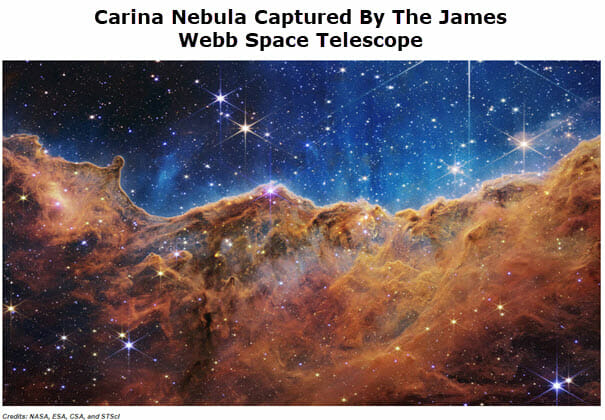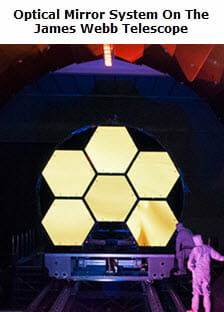This Huge Accomplishment Is More Evidence The New Space Race Is Heating Up…
On December 25, 2021, we took one of the most significant steps to better understand our solar system in history.
That’s the date when the James Webb Space Telescope left Earth and began its month-long journey to a gravitational sweet spot one million miles in outer space.
To get there, it took 20 years of development. More than 7 years of delays. And the final price tag tallied to more than $10 billion.
Once it settled into its new home, it took months to get calibrated and become operational. But on July 11, 2022, the James Webb Space Telescope beamed its first images back to Earth.
And they were breathtaking…
The Ansel Adams-like photographs reached deep into the unknown and revealed parts of the universe that we had never seen before. Crystal-clear images of Neptune’s rings were exposed. Giant celestial landscapes of dust and gas were revealed. The Carina Nebula — home of the unstable supergiant star called Eta Carinae — looks like an art piece that could hang on the wall of some mansion.

But as incredible as the pictures are, they are just the tip of the iceberg. Behind those fantastic images are mountains of data that will reshape our understanding of the universe. Astronomers around the world are salivating at the newfound knowledge the James Webb Telescope is providing.
A Landmark Achievement
This telescope — the largest ever launched into space — is the most ambitious and complex space science observatory ever built. It can detect light from the first stars and galaxies formed in the universe. It will study our cosmic history and unlock discoveries scientists have yet to imagine.
 But this scientific marvel wasn’t just whipped up by some engineers at NASA. No. Several companies had their hand in its development — including a recent recommendation over at Capital Wealth Letter.
But this scientific marvel wasn’t just whipped up by some engineers at NASA. No. Several companies had their hand in its development — including a recent recommendation over at Capital Wealth Letter.
It designed and built the advanced optical technology and lightweight mirror system that enables the James Webb Telescope to look 13.5 billion years back in time.
This isn’t your standard bathroom mirror you look into every morning. The primary mirror is comprised of 18 hexagonal mirror segments, each measuring approximately 4 feet wide. The overall height checks in at more than 21 feet tall. The exact measurements had to be within one ten-thousandth the width of a human hair.
Finally, a set of cryogenic actuators is mounted on each segment to control individual mirror positioning to capture these brilliant images.
In addition to the mirrors, the company designed the electronic controls to operate these mirrors. Mind you, all these components must work in freezing cold temperatures — as in minus 447 degrees Fahrenheit.
This wasn’t the company’s first foray into space hardware, either. It had a hand in designing and developing all four of NASA’s Great Observatories — previous telescopes launched into space, with arguably the best-known one being the Hubble Space Telescope.
The Space Race Is Heating Up
Of course, we can’t exactly invest in the James Webb Telescope. But I bring this up to make a simple point.
There’s no denying that investments in space exploration have exploded over the last decade. Elon Musk has devoted billions to his company, Space X. Richard Branson wants to bring space flight to consumers through Virgin Galactic (NYSE: SPCE). Heck, even Jeff Bezos built his own rocket company (Blue Origin) to take a quick trip to space.
And NASA plans to invest over $80 billion in major projects to continue exploring Earth, the moon, and the solar system.
I’ve been telling my Capital Wealth Letter readers about the new space race for the past two years. And we’ve identified a few select ways for to profit for investors who want to get in on the early stages.
As far as the James Webb Telescope goes, there’s actually a sort-of backdoor play into this. I told my premium readers about it a couple of months ago. It’s a wonderful company that has been around since 1880, and has paid investors a dividend every year for over 40 years. And when we bought it, it was trading at a massive discount… a valuation we haven’t seen since 2015.
Ironically, when I tell you this company’s name, you won’t even realize it is involved in space.
Which brings me to my point…
Closing Thoughts
There are — and will be — plenty of opportunities to invest in space. And I’ll continue to monitor as things unfold and keep readers updated.
But unfortunately, right now, many of the obvious investments just aren’t suitable for most people. I’d wager that many of these smaller companies won’t even be around in five years. Most are losing money hand over fist, as space exploration is terribly capital-intensive. And many of the publicly available options for investors have performed terribly.
There will be times when it makes sense to take a flier on one of the smaller “start-up” companies in this emerging sector. But investors should focus the bulk of their attention on larger companies that are making forays into space.
Right now, these endeavors may be “on the side”. But in the coming years, they could add up to a huge chunk of the company’s overall business. And there will be plenty of gains to be had by smart investors who don’t ignore them.
In the meantime, if you’re looking for more game-changing ideas with serious upside, then you should check out my investment predictions for 2023…
This report is full of research that challenges the conventional wisdom. And while we don’t have a crystal ball, many of our past predictions have come true, allowing investors the chance to rake in gains of 622%, 823%, and even 1,168%.
From the U.S. dollar to driverless trucks to breakthrough cancer treatments and more… If you’re looking for some “home-run” ideas for your portfolio, then I can’t think of a better place to start.
